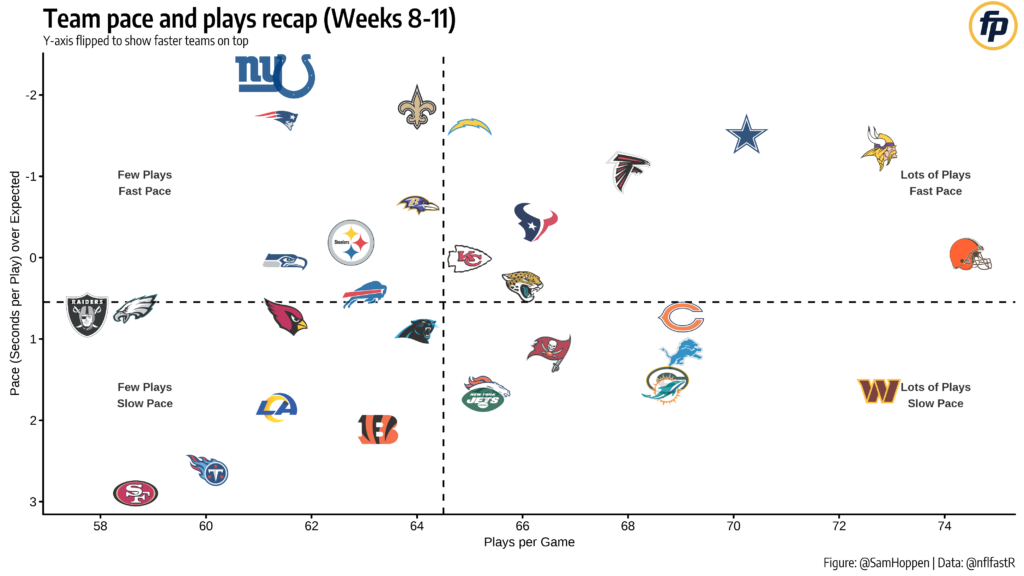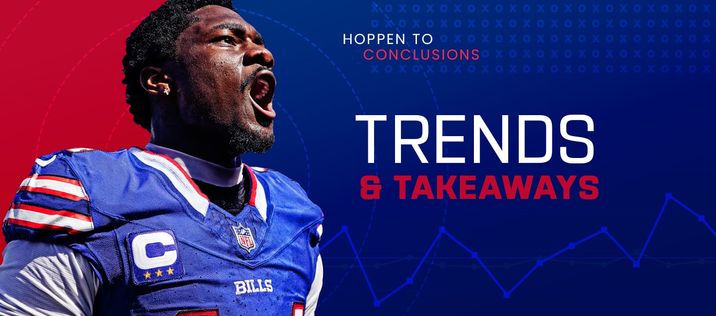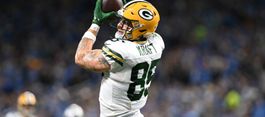Hello and welcome to the Week 12 edition of Hoppen to Conclusions! This is where I, Sam Hoppen, will share some of my favorite charts, which are designed to give you an overview of the NFL landscape. These charts, along with the commentary that I provide, aim to help you make start or sit, DFS lineup construction, betting picks, or any other fantasy football decisions. There can be a lot of noise in fantasy football analysis, but these charts have been carefully selected to give you some of the most relevant and useful decision points.
- Waiver Wire Advice
- Weekly Fantasy Football Expert Rankings
- Fantasy Football Start/Sit Advice
- Fantasy Football Trade Tools
Each of the charts has been designed in a way that you want to target players and teams that are in the top-right quadrant of the chart as denoted by the dotted black lines, which signify the median value for the stat on either the x-axis or y-axis. You’ll notice that I’ve added a second chart to each section. This is the same chart that you’re used to seeing for each section, but looking purely at the last four weeks. As we move through the season, the more recent weeks should hold more weight so this will give you a snapshot of more recent usage and trends! Before getting to each of the charts and analyses, here are some brief descriptions of what you will find on each chart and how to interpret them.
- Team Pace and Plays: Compares a team’s average plays per game to its pace over expected, using seconds per play as a measure of pace. On the chart, the y-axis flipped to show faster-paced teams (running plays faster than expected) on top. Simply put, teams (and overall matchups) with more plays and faster pace will offer more opportunities for fantasy point-scoring.
- Team Pass Rates: Compares a team’s pass rate over expectation (PROE) to its red-zone pass rate. Here we can identify which teams are passing the most when game script isn’t a deciding factor and when they get close to the goal line.
- Running Back Usage: Compares rushing expected fantasy points per game to his receiving expected fantasy points per game, with the size of the player’s point as his snap percentage. I use expected fantasy points as a measure of one’s workload in that specific area of the game, so it can help us discern which players are getting strong rushing or receiving workloads.
- Wide Receiver & Tight End Usage: Compares player weighted opportunity rating (WOPR) to his yards per route run (YPRR), with the size of the player’s point as his routes run rate (as a percent of the team’s dropbacks). WOPR weighs both air yards share and target share to evaluate a player’s opportunity, while yards per route run is a measure of one’s efficiency with the routes (and targets) he’s given. The charts show the same information for both the wide receiver and tight end position.

Fantasy Football Trends & Takeaways
Team Pace and Plays


- I never thought a Week 12 matchup between Baker Mayfield and Gardner Minshew would be one of my favorite games of the week, but here we are. This game figures to be an up-tempo fantasy feast. In case you haven’t followed this article, Indianapolis has been one of the fastest-paced teams all season and creates game environments that are worth attacking. The Colts also use no-huddle a ton — they have yet to have a no-huddle rate below 11% in a single game this season. Indianapolis has totaled just 58 and 56 plays in their last two games after averaging 68.1 plays per game through their first eight games. Tampa Bay hasn’t been all that fast-paced this year, but the Colts’ opponents have the 4th-fastest neutral-script pace this year as they try to keep up with them. As a more run-heavy team, the Buccaneers should also be able to move the ball easily against the Colts as they rank dead last in rushing EPA per play allowed, rushing success rate allowed, and explosive rush rate over the last four weeks.
- Action: bet over 43.5 total points
- The Atlanta Falcons were on a bye this past week, but they made a switch back to Desmond Ridder as their starting quarterback, which drastically changes their pace outlook. With Ridder under center, the percent of plays in which the ball is snapped with less than 10 seconds left jumps to 46.3% compared to 28.9% with Taylor Heinicke. Atlanta has also leaned more run-heavy with Ridder at the helm, meaning the clock will be running more for time to be wasted. It wasn’t a massive difference, but Heinicke also moved the ball a little better with a 0.052 EPA per play compared to a -0.068 EPA per play for Ridder. While you’re still starting the primary players — Bijan Robinson, Drake London, and (if you have the heart) Kyle Pitts — I’m not excited about their ceiling given this change.
- Action: expect Atlanta’s pace to put you to sleep like the tryptophan in your Thanksgiving turkey and fade the Falcons in DFS
Team Pass Rates


- Last week, the Buffalo Bills made waves when they fired their offensive coordinator Ken Dorsey, leaving Joe Brady to call plays. Though it includes just one game with Brady, Buffalo’s PROE has been at -7.8% and -6.5% in their last two games. This coming after Buffalo was a top-five team in PROE through the first nine weeks and had just one negative PROE game in that span. That said, Buffalo’s 62.5% neutral-script pass rate in Week 11 was their third-highest mark of the season, it just means that Buffalo may fall into run-heavy scripts earlier in games should they have a lead to salt away. While the volume for Bills’ pass-catchers is down across the board, this seems to have most negatively impacted Gabe Davis, who didn’t earn a single target in Week 11 after being targeted just eight total times in the two weeks prior. Khalil Shakir‘s route rate has increased dramatically while Dawson Knox has been out (above 68% in each of the last four games), but the lack of volume overall (four targets per game in that span) makes it hard to trust him in lineups, too.
- Action: start only Dalton Kincaid and Stefon Diggs as Bills pass catchers
Running Back Usage
- Just like opinions on Thanksgiving foods (see mine in Quick Hops), the Panthers’ backfield is completely split. After getting a season-high 76% snap share in Week 6, Chuba Hubbard has seen his snap share drop in successive weeks, bottoming out at 49% this past week. Miles Sanders, who missed Week 6, has been subsequently ramped back up in terms of snap share as his has risen in each of the last four weeks. This past week, both Hubbard and Sanders were given 12 total opportunities — it was the first time since Week 3 that Hubbard didn’t have as many or more opportunities than Sanders. Even if one were getting a majority of the opportunities, the Panthers rank 29th in offensive success rate, so the opportunities they’re getting are not very valuable. Between Sanders and Hubbard, there have been just 11 green zone touches for the Panthers (Gus Edwards has 13 on his own in the last four weeks). One of them may find there way to a top-12 RB week, but I’d rather see that on my bench than the more-likely 5.3-point outing.
- Action: leave Chuba Hubbard and Miles Sanders on your bench like you would leave jarred cranberry sauce on the counter
- While the Minnesota Vikings spotlight has been on Joshua Dobbs the past couple of weeks, I’d like to shift your focus to their backfield. Minnesota lost Cam Akers to another torn Achilles (a truly unfortunate circumstance, you gotta feel for the man) in Week 9, leaving the work to be split between Alexander Mattison and Ty Chandler. The usage is muddied a bit as Mattison left Week 10’s game early with a concussion, so both he and Chandler got 44% of the snaps. In Week 11, though, Mattison returned to a 64% snap share and 53% routes run rate, both his highest since Week 6. Still, Chandler was given 14 opportunities for the second game in a row. Fortunately, the HVTs have not dissipated with Dobbs at the helm — Minnesota running backs averaged 6 HVTs with Cousins and a slightly-lower 5.3 HVTs with Dobbs. Typically, a quarterback with the scrambling ability of Dobbs will siphon more HVT opportunities, but that hasn’t been the case. Chandler actually led the backfield with 4 HVTs in Week 11, so he has become one of the most valuable secondary pieces of any backfield.
- Action: buy Alexander Mattison as Minnesota’s RB1, hold Ty Chandler as RB2 and as one of the more valuable handcuffs
Wide Receiver Usage


- Kyler Murray has been back for the Cardinals for two weeks now and he’s changed the makeup of Arizona’s target distribution so far. Through the team’s first nine games, Marquise Brown led the team in routes run rate (94%), targets per route run rate (24%), target share (29%), and air yards share (43%), among other things. In the last two games, Brown has run a route on every Kyler Murray dropback but has just a 12% target share and 9% targets per route run rate. The targets have shifted away from the receivers to tight end Trey McBride, who has 16 total targets in Murray’s two starts. Still, Greg Dortch (remember him?) had eight targets in Week 11, and both Rondale Moore and Michael Wilson had more targets than Brown in Week 10. All that said, I’m buying that the targets will come Brown’s way as he averaged 10.3 targets per game with Murray last year.
- Action: buy Marquise Brown
- Nobody was more excited for Justin Fields‘ return than DJ Moore. In their last three full games together, Moore is averaging 7.6 receptions and 152 receiving yards per game and has scored five touchdowns. Additionally, Moore has an 83% catchable target rate with Fields compared to a 71% catchable target rate with Tyson Bagent. Moore has run a route on 97% of Chicago’s dropbacks this year with the only other receiver with a routes run rate above 50% being Darnell Mooney (81%). However, Mooney is averaging just 3.5 targets per game. With a -6.3% PROE (second-lowest in the league), there’ll be a bigger pumpkin pie on my dining room table this Thanksgiving than the target pie in Chicago.
- Action: buy DJ Moore
- The San Francisco 49ers have bounced back from their three-game losing streak to win back-to-back games. It has, in large part, been due to their offense being at full strength with Deebo Samuel back in the lineup after missing a couple of games. Samuel was eased back into action his first week back with just a 71% routes rate (though that was due to the blowout nature of their Week 10 victory), but ran a route on 97% of dropbacks this past week, his highest total since Week 1. Samuel has earned just four targets in each of the two games for a middling 15% targets per route run rate. Brandon Aiyuk has just one more target across those two games, but he’s playing like a true WR1, boasting an incredible 26.4 yards per reception. Since Week 6, Aiyuk has run a route on fewer than 90% of San Francisco’s dropbacks just once. He’s on the field a ton and is playing incredibly when he gets the ball in his hands, making him a legit WR1 option for fantasy.
- Action: hold Deebo Samuel, buy Brandon Aiyuk as a WR1
Tight End Usage


- Tyler Higbee may be finding his way into more work by virtue of an injury to Cooper Kupp. His usage has been directly tied to Kupp’s presence as he’s averaging nearly double as many targets (6.5) without Kupp playing as targets with Kupp playing (3.4). Higbee’s route participation has continued to remain strong, as he’s been above 73% in every game this year, so if Kupp were to miss more time then Higbee would be a solid fill-in for teams struggling with tight end production.
- Action: add Tyler Higbee if in need of tight end help
Quick Hops
- As I briefly mentioned earlier, Gus Edwards has 5, 2, 2, and 4 green-zone touches in his last four games. He’s the clear RB1 in Baltimore for now, buts Keaton Mitchell‘s snap share has risen in each of the last three weeks. Mitchell has just three total HVTs in those games, so until he siphons more of those Edwards will be just fine.
- Brian Robinson has six and eight HVTs in the last two games and that has come with just one green-zone touch. Robinson earning the pass-catching work in that offense would be a massive boon to his fantasy value.
- In the first game without Dallas Goedert, DeVonta Smith earned a season-high 38% target share. The splits for Smith with Goedert on and off the field continue to be strong.
- The ideal Thanksgiving plate of food is turkey (with gravy), stuffing (also with gravy), green beans (need some veggies), and a warm dinner roll with a slice of pumpkin pie as dessert.
Subscribe: Apple Podcasts | Spotify | Google Podcasts | SoundCloud | iHeartRadio















